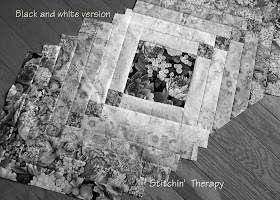This series of posts has been a journey for me.....reviewing some past quilts and braid techniques, and hunting up info to share, and trying to some order into all of it.
Insight: Developing a class or series like this is not easy....it is work! So hug a teacher, they deserve it.
The Faux Braid is a new favorite now.....I think I could put one together blindfolded. It works up fast and easy. So what is it? Simply the quarter log cabin block....with the variation of how the colors or values are placed.
Generally or traditionally, the quarter log cabin block might look like the photo on the right. Each round that is added to the starting square is the same fabric/color.
This photo shows the change in placement for the Faux Braid using the quarter log cabin block. Each round contains a light strip and a dark strip. This arrangement creates a block that is half light and half dark. Then when set together the blocks create a braid effect.
By rotating the block for the layout, the diagonal bands are formed. Note.....very little matching to worry with!
I call this one the soft version. The fabrics are low contrast...a very soothing and restful effect for our troubled world. A nice border and a little applique would finish it off nicely.

And for the flip side.......a version done in leftover batik strips. Same pattern, just different fabrics for a different and stronger voice. This one reminds me of the blue Ridge Mountains that are nearby.
The original tutorial is from Sharon at Vroomansquilts. Be sure to say hello when you check it out.
Based on her tutorial I put together a simple sheet with the construction details. Click here for the printable PDF for the Faux Braid.
I had planned to take a side by side photo for comparison on the deck today, but nature intervened. It is 37 degrees, and raining here, so I resorted to the front porch again. I just wanted the contrast of the 2 versions....one soft and the other stronger. Whatever fabrics you prefer, the Faux Braid will be striking!

Thanks to all for taking the time to read and comment on this series of posts. I hope a few of you will try this fun technique, get over your fear, and figure out which one you prefer. Send me a photo if you dare!
If I am quiet for a few days....don't worry. I have a lot of stuff to clean up in the sewing room, and a couple to quilts to work on. Wishing all a Happy Thanksgiving. I am thankful this is done..... ;)
Happy stitching.
Insight: Developing a class or series like this is not easy....it is work! So hug a teacher, they deserve it.
| Quarter Log Cabin block |
Generally or traditionally, the quarter log cabin block might look like the photo on the right. Each round that is added to the starting square is the same fabric/color.
This photo shows the change in placement for the Faux Braid using the quarter log cabin block. Each round contains a light strip and a dark strip. This arrangement creates a block that is half light and half dark. Then when set together the blocks create a braid effect.
By rotating the block for the layout, the diagonal bands are formed. Note.....very little matching to worry with!
I call this one the soft version. The fabrics are low contrast...a very soothing and restful effect for our troubled world. A nice border and a little applique would finish it off nicely.

And for the flip side.......a version done in leftover batik strips. Same pattern, just different fabrics for a different and stronger voice. This one reminds me of the blue Ridge Mountains that are nearby.
The original tutorial is from Sharon at Vroomansquilts. Be sure to say hello when you check it out.
Based on her tutorial I put together a simple sheet with the construction details. Click here for the printable PDF for the Faux Braid.
I had planned to take a side by side photo for comparison on the deck today, but nature intervened. It is 37 degrees, and raining here, so I resorted to the front porch again. I just wanted the contrast of the 2 versions....one soft and the other stronger. Whatever fabrics you prefer, the Faux Braid will be striking!

Thanks to all for taking the time to read and comment on this series of posts. I hope a few of you will try this fun technique, get over your fear, and figure out which one you prefer. Send me a photo if you dare!
If I am quiet for a few days....don't worry. I have a lot of stuff to clean up in the sewing room, and a couple to quilts to work on. Wishing all a Happy Thanksgiving. I am thankful this is done..... ;)
Happy stitching.





















